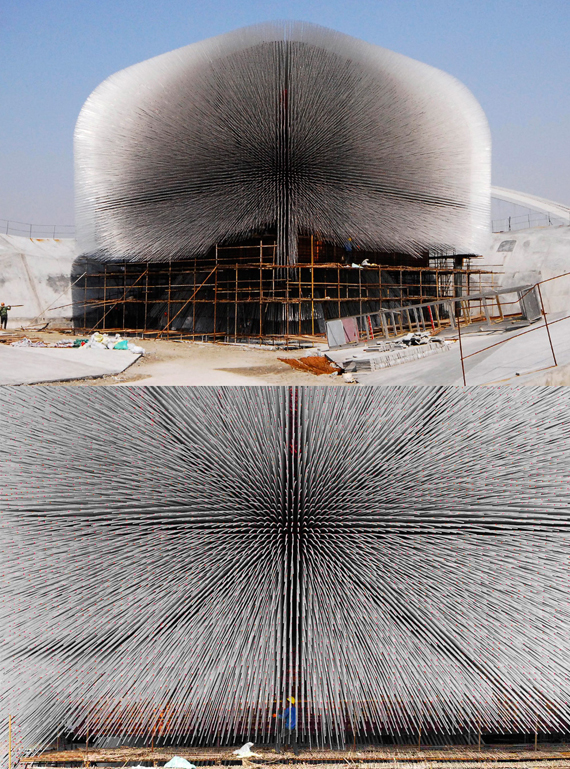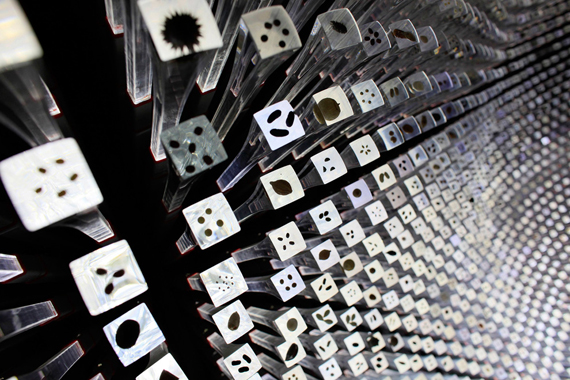Six trailers for Socialisme, the director’s submission for the “Un Certain Regard” category at the 2010 Cannes Film Festival.
Six trailers for Socialisme, the director’s submission for the “Un Certain Regard” category at the 2010 Cannes Film Festival.
Her pure nails sprung up exalting their onyx,
Anxiety, this midnight, bearing light, sustains,
In twilight many dreams burnt up by the Phoenix
Whose smoky ashes no sepulchral urn contains
Atop the sideboards, in the empty room: no ptyx,
That voided toy of vibrant nonsense, left inside,
(Because the Master’s gone to draw the tears from Styx
With that exclusive object wherein Naught takes pride.)
In vacant north seen through the casement frames, a gold
May agonize at times, within the setting, to behold
Fire-breathing unicorns arrayed against a nix,
She, lifeless naked mirror image, repetition
Whom in the twinkling framed forgetting, is to fix
Through sparkling timed in septet, composition.
Translated by MX
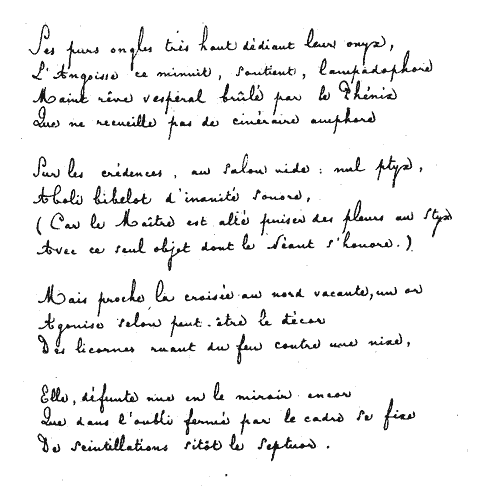
In 2007 I shot ten scenes for a feature length project called The Upper Air, but I was dissapointed with the results and scrapped the project. I've decided to re-edit the scenes into a short entitled yx, which will hopefully be finished next month. The themes and concept are very much the same as the original project: the privitization of resources and of bodies, the translation of hermetic spaces into hermetic narratives, allegories of ecologies in crisis. The new title comes from Stéphane Mallarmé's poem, Sonnet en -yx. The video has performances by Jeff Harms and Evan Rubin, and Sam Wagster was an immense help in the production. Below are some stills from the edit in progress.
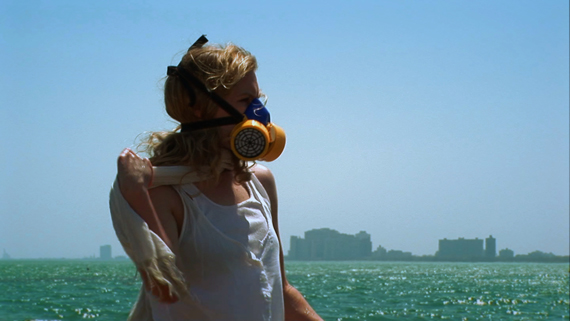




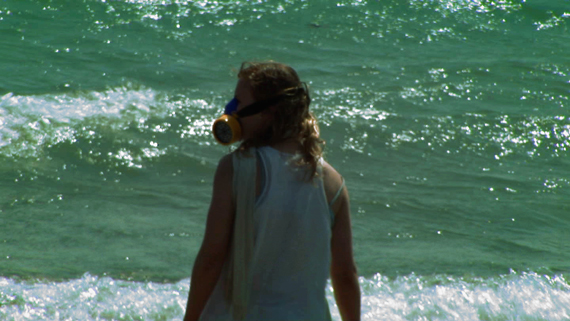
 Max Ernst, Epiphany (1940)
Max Ernst, Epiphany (1940)
Whenever desire climbs a tree, internal repercussions trip it up and it falls to its death; the rhizome, on the other hand, acts on desire by external, productive outgrowths. That is why it is so important to try the other, reverse but non-symmetrical, operation. Plug the tracings back into the map, connect the roots or trees back up with a rhizome.
Gilles Deleuze and Félix Guattari, A thousand plateaus: capitalism and schizophrenia.
An emergent thought:
The recognition of the illusion of economic growth is a symptom of a crisis — a self-betrayal of the materiality of capital in the grain-become-visible in the tightly stretched membrane. Crisis relocates idealist and utopian strategies from the hypothetical and fantastic to within the possible, pragmatic and even necessary. It brings the holistic and broad to bear upon the specific, and the local — global ecology becomes tangibly present in everyday negotiations of individuals and small communities. Unexpected regions of the metaphysical materialize as we are forced to perceive the interconnectedness of living beings and the power of cosmologies to inform, motivate and direct human behavior. The neurotic visions of post-apocalypse projected by the philosophies of growth, industry and economic disparity reveal their attractive democratic foundations, the leveling of qualities of life and the rationality becomes evident in post-industrial models. Intrinsic rights of the individual cannot be argued to be dependent upon individualist goals, and it becomes urgently necessary and unavoidable to conceive of communal organizational structures which function as part of a whole. It becomes undeniable that our belief in a better possible future, so necessary to undertake the difficult work of reaching it, is part of a long, intertwining and diverse lineage of holistic beliefs that have always existed and been valuable, yet were not always recognized outside of the codified boundaries of official culture. Essentially, to instrumentalize belief, we assume an analytical (extra-dimensional) vantage, creating in the zone of the singularity — the space in which belief is transformed into objective forces by “necessity” — a probability map of possible positions and trajectories.
I have a sense that we need to, in communities of natural human scale, carefully and analytically revive the historical records of cultural ecologies — the materially conjoined structures of human organization and natural environments — with projected relevance in inverse proportion to their proximity to the epicenters of empires. We have firmly entered the borderlands — the frontline of the conflict between programmatic expansionism and the indigenous, the genesis of synthetic cultures that from the inside appeared occult and mystical and which, in the analytical revival is revealed to be programmed by holistic mythologies. Here and now we will reconfigure the historical syntheses of nomadic federations and city-states. The border is still being pushed outward, but when we look toward the future-past, we can begin to re-imagine practices of ecological existence and experience — formerly maligned as “primitive” and “superstitious” — as praxises arisen from sound, resonant and beautiful theory. Such an analytical retracing becomes a novel progression, taking what once came after with us into what once came before.
Perhaps this precludes an inversion of the deepest sense of deterritorialization. Perhaps this prefigures a recorporation of the imaginary body.


Your making things explicit, 2009. Installation by Olafur Eliasson.
Dario Robleto was born in 1972 in San Antonio, Texas; he lives and works in San Antonio. In his sculptures, Robleto uses rare and archaic materials, including vinyl records, dinosaur fossils, and impact glass formed by meteorites or nuclear explosions. Taking his cue from disc jockeys' music sampling, Robleto refers to history, memory, nostalgia, chance, and hope in order to understand the present. Sampling is a method of composing something new from existing sources in a nonlinear manner. To Robleto, this is a philosophy rooted in American history, rather than just a technique. His sculptures originate from his extensive research around an event, which eventually brings him to identify specifically evocative materials and forms. While his earlier work focused mostly on the history of rock and pop music and its relationship to official history and our personal lives, much of Robleto's more recent work references the experience of war, raising such questions as "who is the enemy?" (Scope).

A Homeopathic Treatment For Human Longing, 2008
Glass vials, vintage glass electrode wands, 19th c. bloodletting cupping glass, various home made homeopathic remedies (sound of glaciers melting, voice of oldest to ever live, last heartbeats of loved one, million year old blossom, million year old raindrop, deceased lovers heartbeats, extinct animal sounds, extinct languages), various custom ordered remedies made by professional homeopath (black amber, willow, tears, mammoth hair, glacial runoff, voice of oldest widow, black swan bone dust, Silvia Plath's voice), velvet, silk, leather ribbon, brass, iron, cork, pine, typeset.

Love Has Value Because It's Not Eternal, 2008
Hand blown glass beakers, stretched audio tape of field recordings of the sound of glaciers melting (2005-06) intertwined with audio tape of various lovers recording their partner's heartbeats as they reflected on each other, ground passion flower, amber, eternal flower, resurrection plant, silk, satin, leather, ribbon, brass, iron, cork, pine, typeset.
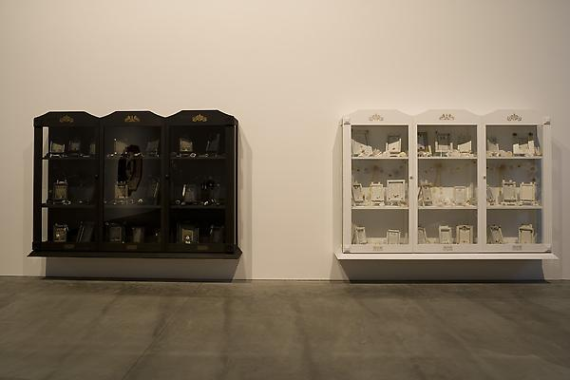
The Boundary of Life Is Quietly Crossed (left), 2008
The Ark of Frailty (right), 2008

The Boundary of Life Is Quietly Crossed, 2008
Ink dyed poplar, typeset on cardstock, hair lockets made of stretched and curled audio tape recordings of supercentenarians (human living to 110 or older), 19th c. hair flowers, lace and fabric from widows' mourning dresses, colored paper, silk, antique ribbon, homemade paper, willow.

Ark of Frailty, 2008
Poplar, typeset on cardstock, hair lockets made of stretched and curled audio tape recordings of "Lazarus species" (species that are rediscovered alive after being classified extinct) in the wild, 19th c. hair flowers, 19th c. dried flowers, lace and fabric from widows' mourning dresss, colored paper, silk, antique ribbon and buttons, carved animal bone buttons, homemade paper, willow, ash, white oak, milk paint, glass.
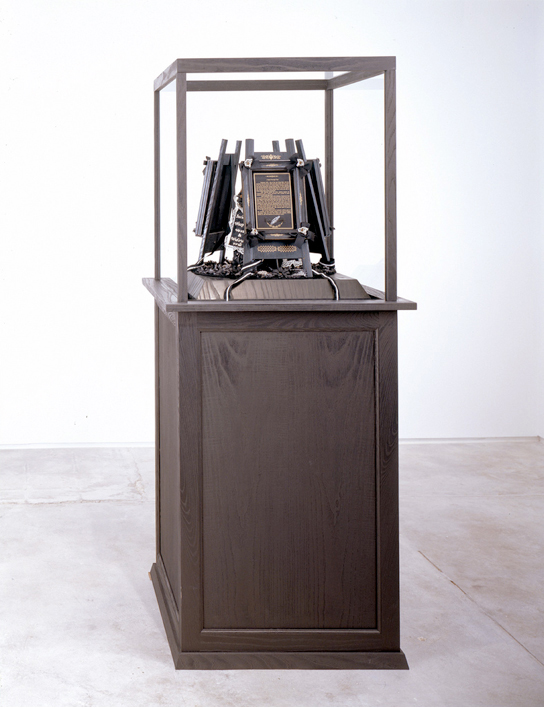
The Pause Became Permanence, 2005-2006
Ink dyed willow and ash, hair lockets made of stretched and curled audio tape recordings of the last known Confederate and Union Civil War soldier's voices, excavated and melted shrapnel from various wars, hair flowers braided by war widows, mourning dresses, colored paper, silk, ribbon, milk paint, glass, typeset.
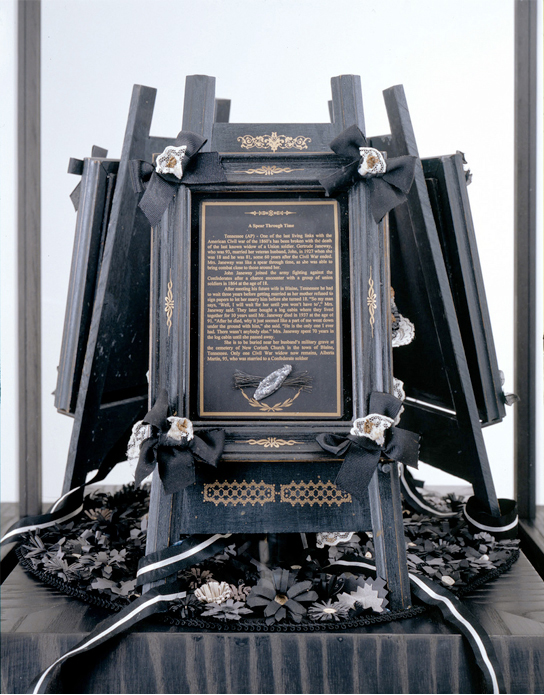
The Pause Became Permanence (detail), 2005-2006
Lynn Margulis discusses her work as a synthetic thinker in the biological, chemical, physical and geological sciences, and describes some of the background of her work on the theory of symbiogenesis, as well as Gaia theory with James Lovelock and Carl Sagan. I find her work to be underrecognized outside of the sciences, in particular in the discourse of human evolution and mimetics, which relies on the outdated and dubious philosophies of Richard Dawkins and other classical Darwinists. Her work should be of the utmost interest to the philosophies of identity and information ecology (mimetics).
From the Institute for Science, Engineering and Public Policy
Lynn Margulis
Distinguished University Professor in the Department of Geosciences, University of Massachusetts, Amherst, is a member of the National Academy of Sciences and the Russian Academy of Natural Science. She received a National Medal of Science from President Clinton in 2000.
Her books include What is Life?, What is Sex?, Slanted Truths (all co-authored with Dorian Sagan) and Symbiotic Planet.
THE ENDOSYMBIOTIC THEORY
Dr. Margulis has proposed that eukaryotic flagella and cilia may have arisen from endosymbiotic spirochetes, but these organelles do not contain DNA and do not show any ultrastructural similarities to any prokaryotes, and as a result this idea does not have wide support. Margulis claims that symbiotic relationships are a major driving force behind evolution. According to Margulis and Sagan (1996), "Life did not take over the globe by combat, but by networking" (i.e., by cooperation, interaction, and mutual dependence between living organisms). She considers Darwin's notion of evolution driven by competition to be incomplete.
SYMBIOGENESIS
Symbiogenesis is a theory of evolution. It argues that symbiosis is a primary force of evolution, because acquisition and accumulation of random mutations or genetic drift are not sufficient to explain how new inherited variations occur. According to this theory, new cell organelles, new bodies, new organs and new species arise from symbiosis, in which independent organisms merge to form composites. This challenges some standard textbook ideas of how evolutionary change occurs. To some degree, Darwin emphasized competition as the primary driving process of evolution, symbiogenesis emphasizes that co-operation can also be important to the process of evolution.
Symbiogenesis was first formulated by K. S. Mereschkovsky (1855-1921) in his 1926 book "Symbiogenesis and the Origin of Species" and by Ivan Wallin, in "Symbionticism and the Origins of Species". Ivan Wallin proposed in 1927 that bacteria might represent the fundamental cause of the origin of species, and that the creation of a species may occur via endosymbiosis.
In the late 20th century, Lynn Margulis claimed that microorganisms are one of the major evolutionary forces in the origin of species, endosymbiosis of bacteria being responsible for the creation of complex forms of life.
Margulis' theory of symbiogenesis
Margulis emphasizes that bacteria and other microorganisms actively participated in shaping the Earth, and helped create conditions suitable for life (e.g., almost all eukaryotes require oxygen, and only developed after cyanobacteria have produced enough atmospheric oxygen). She also argues that these microorganisms still maintain current conditions and that they constitute a major component in Earth biomass.
She showed that free-living bacteria and other microorganisms tend to merge with larger life forms, seasonally and occasionally, or permanently, perhaps under stress conditions. In the now generally accepted endosymbiotic theory, Margulis demonstrated that current plant cells resulted from the merging of separate ancestors, the chloroplast evolving from endosymbiotic cyanobacteria (autotrophic prokaryotes). A more recent additional hypothesis for the origin of some algal and plant cells is the fusion of Thermoplasma (sulfur reduction, fermentation), Spirochaeta (motility), alpha-proteobacteria (oxygen respiration) and Synechococcus cyanobacteria (photosynthesis).
Margulis claims that most of the DNA found in the cytoplasm of animal, plant, fungal and protist cells originated as genes of bacteria that became organelles, rather than from genetic drift or mutation.
Along these lines Margulis has argued that bacteria have the ability to exchange genes very easily and quickly, even between different species, by conjugation or through plasmids. For these reasons, the genetic material of bacteria is much more versatile than that of the eukaryote (see Primary nutritional groups for more on the extent of bacterial ability in terms of nutrition). Margulis claims that versatility is the process which enabled life to evolve so quickly, as bacteria were able to adapt to initial conditions of environment and to new changes by other bacteria.
Animation techniques are used to elucidate anamophosis, a method of depiction that uses the rules of perspective to systematically distort an image. When looked at from a different angle or in a curved mirror, the distorted image appears normal. Using animation of three-dimensional objects, the filmmakers demonstrate the basic effects of anamorphosis and reveal the hidden meanings that lurk within selected works of art, including a chair by Jean François Nicéron (c.1638), an anonymous painting of saints (c.1550), the fresco "Saint Francis of Paola" (1642) by Emmanuel Maignan in the cloister of Santa Trinità in Rome, and the painting "The Ambassadors" (1533) by Hans Holbein the younger.
 Untitled (Girl) by Zabka Britton. White light transmission, film. 5 in x 4 in. 1980-1981.
Untitled (Girl) by Zabka Britton. White light transmission, film. 5 in x 4 in. 1980-1981.

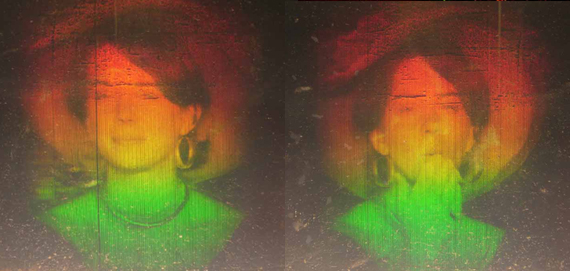 The Kiss by Lloyd G. Cross. 120° integral stereogram (Multiplex), film. 9 1/2 in x 30 in. 1973.
The Kiss by Lloyd G. Cross. 120° integral stereogram (Multiplex), film. 9 1/2 in x 30 in. 1973.
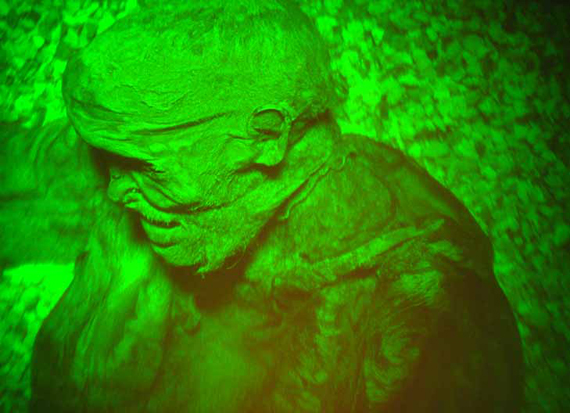 Lindow Man by Richmond Holographic Studios Ltd. Reflection hologram, glass. 12 in x 16 in. 1987. Green image showing the remains of a mummified, Iron Age man, dating to approximately 55BCE, found in a peat bog near Wilmslow, England in 1983.
Lindow Man by Richmond Holographic Studios Ltd. Reflection hologram, glass. 12 in x 16 in. 1987. Green image showing the remains of a mummified, Iron Age man, dating to approximately 55BCE, found in a peat bog near Wilmslow, England in 1983.
 Parc des Folies a la Villette by A. P. Holographie. White light transmission, film. 38 in x 40 in. Circa 1983. 3-D architect's model, produced to promote this science park in Paris; rainbow-colored image.
Parc des Folies a la Villette by A. P. Holographie. White light transmission, film. 38 in x 40 in. Circa 1983. 3-D architect's model, produced to promote this science park in Paris; rainbow-colored image.
Selections from the MIT Museum exhibit: Holography: The Light Fantastic, "an awe-inspiring sampling of twenty-three historic holograms from the MIT Museum holography collection—the world's largest. Scientific and artistic applications of holography in diverse fields such as medicine, engineering, and retailing as well as architecture, portraiture and abstract art are represented."
Here are some stunning images of the Seed Cathedral and UK Pavillion, designed by Thomas Heatherwick for the 2010 Shanghai World Expo.
